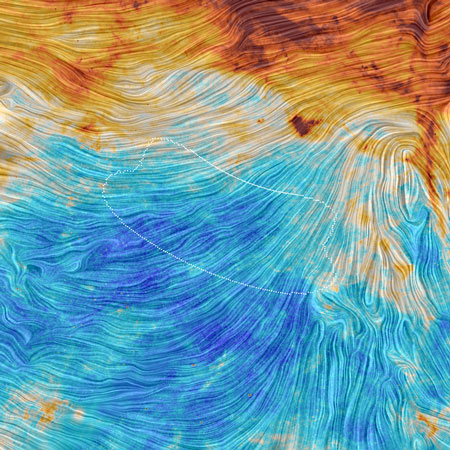| Feb 02, 2015 |
Still doubts on gravitational waves
|
|
(Nanowerk News) Third (and most probably not the last) chapter in the ongoing story about the "first direct image of gravitational waves through the primordial sky". In March last year the BICEP2 team announced that it had observed the portion of cosmic background radiation (the "fossil radiation" from the Big Bang) generated by gravitational waves. In other words, this would have been the first observation of the cosmological effects of this important yet elusive phenomenon predicted by Einstein's theory of General Relativity. If confirmed, the discovery would have been a milestone in the history of astrophysics, cosmology and physics of fundamental forces.
|
|
For that very reason, the news made several people prick up their ears: "Are we sure that the signal observed is genuine and not the effect of contaminants due to the polarised emission of our Galaxy?" The team, however, excluded that possibility: even in the March paper the researchers stated that current knowledge indicates that contaminating radiation is small compared to the observed signal.
|
|
Planck's response arrived in September, and basically said: "Watch out, our data have shown that polarised galactic radiation is not negligible in these measurements". In this setting, Planck's voice is authoritative as the instrument (also) observes the same portion of sky as BICEP2, with the advantage that it uses a far wider range of frequencies.
|
 |
| This image shows a patch of the southern sky and is based on observations performed by ESA’s Planck satellite at microwave and sub-millimetre wavelengths. The colour scale represents the emission from dust, a minor but crucial component of the interstellar medium that pervades our Milky Way galaxy. The texture, instead, indicates the orientation of the Galactic magnetic field. It is based on measurements of the direction of the polarised light emitted by the dust. The highlighted region shows the position of a small patch of the sky that was observed with two ground-based experiments at the South Pole, BICEP2 and the Keck Array, and yielding a possible detection of curly B-modes in the polarisation of the Cosmic Microwave Background (CMB), the most ancient light in the history of the Universe. However, a joint analysis of data from BICEP2, the Keck Array, and Planck has later shown that this signal is likely not cosmological in nature, but caused by dust in our Galaxy. The image shows that dust emission is strongest along the plane of the Galaxy, in the upper part of the image, but that it cannot be neglected even in other regions of the sky. The small cloud visible in red, to the upper right of the BICEP2 field, shows dust emission from the Small Magellanic Cloud, a satellite galaxy of the Milky Way. The image spans 60º on each side. (Image: ESA)
|
|
And now to the present. After September BICEP2 and Planck joined forces to work on the problem, and their collaboration has resulted in a study just published in Physical Review Letters, which further confirms the Planck view: despite a more in-depth analysis and the acquisition of a new instrument (Keck) by BICEP2, we confirm that the galactic contaminants are sufficiently intense to preclude, given the current state of equipment and quality of data, any definite statement concerning the presence or absence of cosmological gravitational waves.
|
|
"Basically, what we conclude", explains Carlo Baccigalupi, SISSA cosmologist and one of the authors of the paper, "is that no investigation of this kind can escape a systematic study of contaminating sources. And it can only be systematic if several instruments are used at the same time". Planck can act as an "alarm bell", but owing to its very nature and the instrumental noise contained in its observations, it requires additional, "sharper" eyes to better distinguish the signal.
|
|
"Our work isn't over", concludes Baccigalupi. "Current experiments (including BICEP2) and future projects (a new satellite, a 'descendent' of Planck called CORE+ has just been proposed to the European Space Agency) have understood the message of Planck and BICEP2 very well, and are planning to equip themselves with technology capable of observing the Galaxy with very sharp eyes, to be able to distinguish it from the signal of the Big Bang, if indeed it did emit gravitational waves".
|
|
More in detail...
|
|
Planck is a European Space Agency satellite, designed to observe, with an unprecedented degree of accuracy, the Big Bang through cosmic microwave background radiation. Proposed in the early 90s, the satellite and its instruments were developed thanks to huge efforts that involved several national space agencies in Europe coordinated by ESA, whereas the NASA developed the cooling system.
|
|
On-ground analysis of the data has been conducted in only two centres in the world, Paris and Trieste. In Trieste, in particular, SISSA, INAF-Astronomical Observatory of Trieste, and the University of Trieste participate in the Data Processing Centre for the low-frequency instrument. In recent years, about fifteen scientists from the three institutions collaborated intensely with continuous exchanges with the rest of the Planck collaboration made up of the world's leading experts in data analysis, computer science, cosmology and astrophysics for a total of over 200 scientists and technicians.
|

